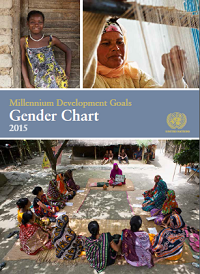Gender Chart reveals how women fared in 2015 global progress
Date:
The Millennium Development Goals (MDGs) are behind us now, but as we embark on a new era and take stock of what is left to do, we find progress continues to bypass women, especially the poorest and most marginalized. On the whole, women face greater vulnerability to poverty than men, earn 24 per cent less globally, and despite advances in recent years, hold just 22 per cent of parliamentarian seats. An estimated 303,000 women died in 2015 during pregnancy or from childbirth-related complications, most of these due to a lack of access to basic health care services. These are some of the messages of the final edition of Sustainable Development Goals begin to take their place.
The 2015 Gender Chart, an addendum to the UN Secretary-General's 2015 Millennium Development Goals Report, focuses not just on Goal 3, which calls for gender equality and women's empowerment, but also tracks how gender equality is impacted by the remaining seven MDGs. By looking at the other goals from a gender perspective, the Gender Chart also emphasizes the inter-linkages between the goals and gender equality and women's empowerment, in making progress on development and in achieving the MDGs.
The 2015 Gender Chart shows that while progress has been made in a number of the gender dimensions of the MDGs, such as in education, where the gender gap in youth literacy has narrowed substantially, and in maternal mortality, which has declined by nearly 44 per cent since 1990, more needs to be done. Women and girls need to be at the centre of any development imperative. And now, with Member States jointly adopting the ambitious 2030 Agenda for Sustainable Development, the aim is clear: Pick up where the MDGs left off, and ensure a comprehensive agenda that fully addresses gender equality and women’s empowerment head on.
Jointly produced by UN Women and the UN Statistics Division based on a set of data compiled by the Inter-Agency and Expert Group on MDG Indicators, the gender chart has been a recurring publication that charted progress towards the time-bound MDG targets set by world leaders in 2000 from a gender perspective.
Related links
